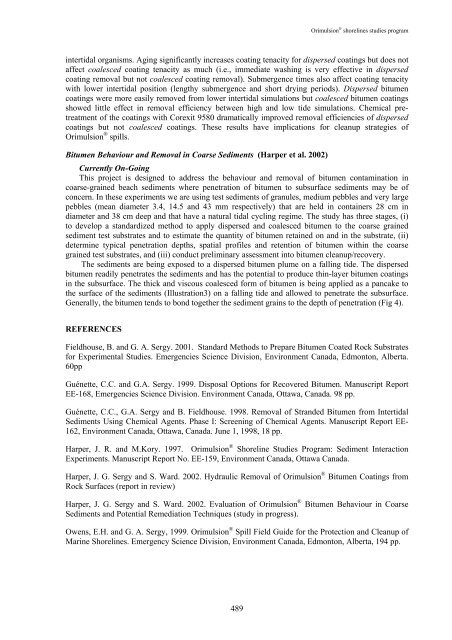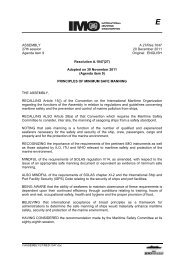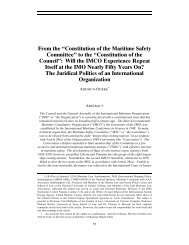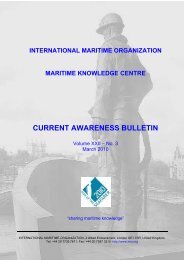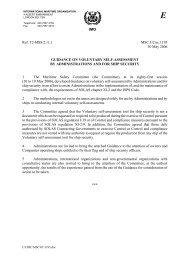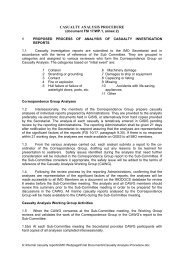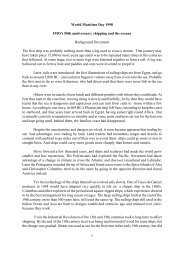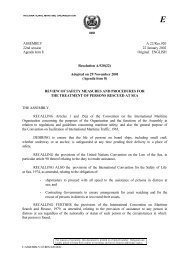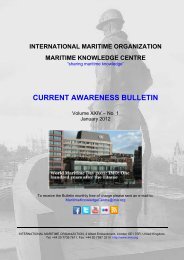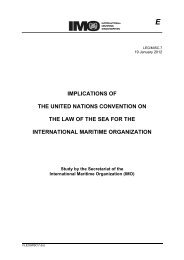- Page 1 and 2:
Troisième Forum R&D La lutte en me
- Page 3 and 4:
Troisième Forum R&D La lutte en me
- Page 5:
Troisième Forum R&D La lutte en me
- Page 8 and 9:
Troisième Forum R&D La lutte en me
- Page 10 and 11:
Troisième Forum R&D La lutte en me
- Page 13:
Session d'ouverture
- Page 16 and 17:
Troisième Forum R&D La lutte en me
- Page 18 and 19:
Allocution d’ouverture Tom Allan
- Page 20 and 21:
Troisième Forum R&D La lutte en me
- Page 23 and 24:
COMPOSITION, PROPRIETES ET CLASSIFI
- Page 25 and 26:
Composition, propriétés et classi
- Page 27 and 28:
Composition, propriétés et classi
- Page 29 and 30:
Composition, propriétés et classi
- Page 31 and 32:
Composition, propriétés et classi
- Page 33 and 34:
Composition, propriétés et classi
- Page 35 and 36:
Composition, propriétés et classi
- Page 37 and 38:
Composition, propriétés et classi
- Page 39 and 40:
ÉTUDE DES PROBLEMES CAUSES PAR LES
- Page 41 and 42:
Étude des problèmes causés par l
- Page 43 and 44:
Étude des problèmes causés par l
- Page 45 and 46:
Étude des problèmes causés par l
- Page 47 and 48:
Étude des problèmes causés par l
- Page 49 and 50:
Étude des problèmes causés par l
- Page 51:
Étude des problèmes causés par l
- Page 55 and 56:
LA DETECTION A DISTANCE PAR SATELLI
- Page 57 and 58:
La détection à distance par satel
- Page 59 and 60:
La détection à distance par satel
- Page 61 and 62:
La détection à distance par satel
- Page 63 and 64:
LA DETECTION A DISTANCE DE PETROLE
- Page 65 and 66:
La détection à distance de pétro
- Page 67 and 68:
La détection à distance de pétro
- Page 69 and 70:
La détection à distance de pétro
- Page 71 and 72:
La détection à distance de pétro
- Page 73 and 74:
Suivi des fuels immergés A cause d
- Page 75 and 76:
Suivi des fuels immergés − lié
- Page 77 and 78:
Suivi des fuels immergés rapidemen
- Page 79 and 80:
Un modèle opérationnel de dispers
- Page 81 and 82:
Un modèle opérationnel de dispers
- Page 83 and 84:
Un modèle opérationnel de dispers
- Page 85 and 86:
Un modèle opérationnel de dispers
- Page 87 and 88:
Un modèle opérationnel de dispers
- Page 89 and 90:
Développement d’un système de p
- Page 91 and 92:
Développement d’un système de p
- Page 93 and 94:
Développement d’un système de p
- Page 95 and 96:
Développement d’un système de p
- Page 97 and 98:
Développement d’un système de p
- Page 99 and 100:
VERS UNE MEILLEURE PREVISION DE LA
- Page 101 and 102:
Vers une meilleure prevision de la
- Page 103 and 104:
Vers une meilleure prevision de la
- Page 105 and 106:
Vers une meilleure prevision de la
- Page 107 and 108:
Vers une meilleure prevision de la
- Page 109 and 110:
Vers une meilleure prevision de la
- Page 111 and 112:
Évaluation initiale de la détecti
- Page 113 and 114:
Évaluation initiale de la détecti
- Page 115 and 116:
Évaluation initiale de la détecti
- Page 117 and 118:
Évaluation initiale de la détecti
- Page 119 and 120:
Évaluation initiale de la détecti
- Page 121 and 122:
Évaluation initiale de la détecti
- Page 123 and 124:
Expérience de largage de bitume é
- Page 125 and 126:
Expérience de largage de bitume é
- Page 127 and 128:
Expérience de largage de bitume é
- Page 129 and 130:
Expérience de largage de bitume é
- Page 131 and 132:
Détection de résidus d’Orimulsi
- Page 133 and 134:
Détection de résidus d’Orimulsi
- Page 135 and 136:
Détection de résidus d’Orimulsi
- Page 137 and 138:
Détection de résidus d’Orimulsi
- Page 139:
Session II: Comportement et vieilli
- Page 142 and 143:
Troisième Forum R&D La lutte en me
- Page 144 and 145:
Troisième Forum R&D La lutte en me
- Page 146 and 147:
Troisième Forum R&D La lutte en me
- Page 148 and 149:
Troisième Forum R&D La lutte en me
- Page 150 and 151:
Troisième Forum R&D La lutte en me
- Page 152 and 153:
Troisième Forum R&D La lutte en me
- Page 154 and 155:
Troisième Forum R&D La lutte en me
- Page 156 and 157:
Troisième Forum R&D La lutte en me
- Page 158 and 159:
Troisième Forum R&D La lutte en me
- Page 160 and 161:
Troisième Forum R&D La lutte en me
- Page 162 and 163:
Troisième Forum R&D La lutte en me
- Page 164 and 165:
Troisième Forum R&D La lutte en me
- Page 166 and 167:
Troisième Forum R&D La lutte en me
- Page 168 and 169:
HUILES VEGETALES ET FIOULS LOURDS :
- Page 170 and 171:
Troisième Forum R&D La lutte en me
- Page 172 and 173:
Troisième Forum R&D La lutte en me
- Page 174 and 175:
Troisième Forum R&D La lutte en me
- Page 176 and 177:
Troisième Forum R&D La lutte en me
- Page 178 and 179:
Troisième Forum R&D La lutte en me
- Page 180 and 181:
Troisième Forum R&D La lutte en me
- Page 182 and 183:
Troisième Forum R&D La lutte en me
- Page 184 and 185:
Troisième Forum R&D La lutte en me
- Page 186 and 187:
VIEILLISSEMENT DE PRODUITS PETROLIE
- Page 188 and 189:
Troisième Forum R&D La lutte en me
- Page 190 and 191:
Troisième Forum R&D La lutte en me
- Page 192 and 193:
Troisième Forum R&D La lutte en me
- Page 194 and 195:
Troisième Forum R&D La lutte en me
- Page 196 and 197:
Troisième Forum R&D La lutte en me
- Page 198 and 199:
Troisième Forum R&D La lutte en me
- Page 200 and 201:
Troisième Forum R&D La lutte en me
- Page 202 and 203:
Troisième Forum R&D La lutte en me
- Page 204 and 205:
Troisième Forum R&D La lutte en me
- Page 206 and 207:
Troisième Forum R&D La lutte en me
- Page 208 and 209:
Troisième Forum R&D La lutte en me
- Page 210 and 211:
ORIMULSION ® EVOLUTION ECOLOGIQUE,
- Page 212 and 213:
Troisième Forum R&D La lutte en me
- Page 214 and 215:
Troisième Forum R&D La lutte en me
- Page 216 and 217:
Troisième Forum R&D La lutte en me
- Page 218 and 219:
Troisième Forum R&D La lutte en me
- Page 220 and 221:
Troisième Forum R&D La lutte en me
- Page 222 and 223:
Troisième Forum R&D La lutte en me
- Page 224 and 225:
Troisième Forum R&D La lutte en me
- Page 226 and 227:
Troisième Forum R&D La lutte en me
- Page 228 and 229:
DECONTAMINATION ET PREVENTION DES D
- Page 230 and 231:
Troisième Forum R&D La lutte en me
- Page 232 and 233:
Troisième Forum R&D La lutte en me
- Page 234 and 235:
Troisième Forum R&D La lutte en me
- Page 236 and 237:
Troisième Forum R&D La lutte en me
- Page 238 and 239:
Troisième Forum R&D La lutte en me
- Page 240 and 241:
BIODEGRADATION DU FUEL DE L’ERIKA
- Page 242 and 243:
Troisième Forum R&D La lutte en me
- Page 244 and 245:
Troisième Forum R&D La lutte en me
- Page 246 and 247:
Troisième Forum R&D La lutte en me
- Page 249 and 250:
LA RECUPERATION EN MER D’HYDROCAR
- Page 251 and 252:
La récupération en mer d’hydroc
- Page 253 and 254:
La récupération en mer d’hydroc
- Page 255 and 256:
La récupération en mer d’hydroc
- Page 257 and 258:
La récupération en mer d’hydroc
- Page 259 and 260:
La récupération en mer d’hydroc
- Page 261 and 262:
"LAISSEZ LE PETROLE S’ECHOUER SUR
- Page 263 and 264:
"Laissez le pétrole s’échouer s
- Page 265 and 266:
"Laissez le pétrole s’échouer s
- Page 267 and 268:
"Laissez le pétrole s’échouer s
- Page 269 and 270:
"Laissez le pétrole s’échouer s
- Page 271 and 272:
"Laissez le pétrole s’échouer s
- Page 273 and 274:
Réalités des taux de rencontre de
- Page 275 and 276:
Réalités des taux de rencontre de
- Page 277 and 278:
Réalités des taux de rencontre de
- Page 279 and 280:
Réalités des taux de rencontre de
- Page 281 and 282:
Réalités des taux de rencontre de
- Page 283 and 284:
ETAT DE PREPARATION A LA RECUPERATI
- Page 285 and 286:
État de préparation à la récup
- Page 287 and 288:
État de préparation à la récup
- Page 289 and 290:
État de préparation à la récup
- Page 291 and 292:
État de préparation à la récup
- Page 293 and 294:
État de préparation à la récup
- Page 295 and 296:
État de préparation à la récup
- Page 297 and 298:
État de préparation à la récup
- Page 299 and 300:
État de préparation à la récup
- Page 301 and 302:
Étude de systèmes de récupérati
- Page 303 and 304:
Étude de systèmes de récupérati
- Page 305 and 306:
Étude de systèmes de récupérati
- Page 307 and 308:
Étude de systèmes de récupérati
- Page 309 and 310:
Étude de systèmes de récupérati
- Page 311 and 312:
Étude de systèmes de récupérati
- Page 313 and 314:
Étude de systèmes de récupérati
- Page 315 and 316:
LE POMPAGE ASSISTE DES HYDROCARBURE
- Page 317 and 318:
Le pompage assisté des hydrocarbur
- Page 319 and 320:
Le pompage assisté des hydrocarbur
- Page 321 and 322:
Le pompage assisté des hydrocarbur
- Page 323 and 324:
Le pompage assisté des hydrocarbur
- Page 325 and 326:
Développement et test de technique
- Page 327 and 328:
Développement et test de technique
- Page 329 and 330:
Développement et test de technique
- Page 331 and 332:
Développement et test de technique
- Page 333 and 334:
Développement et test de technique
- Page 335 and 336:
Développement et test de technique
- Page 337 and 338:
Développement et test de technique
- Page 339 and 340:
Développement et test de technique
- Page 341 and 342:
Développement et tests en réservo
- Page 343 and 344:
Développement et tests en réservo
- Page 345 and 346:
Développement et tests en réservo
- Page 347 and 348:
Développement et tests en réservo
- Page 349 and 350:
PREMIERES MESURES DE LUTTE CONTRE L
- Page 351 and 352:
Premières mesures à mettre en oeu
- Page 353 and 354:
Premières mesures à mettre en oeu
- Page 355 and 356:
Premières mesures à mettre en oeu
- Page 357 and 358:
Premières mesures à mettre en oeu
- Page 359 and 360:
Premières mesures à mettre en oeu
- Page 361:
Premières mesures à mettre en oeu
- Page 365 and 366:
PRODUITS CHIMIQUES ET HYDROCARBURES
- Page 367 and 368:
Produits chimiques et hydrocarbures
- Page 369 and 370:
Produits chimiques et hydrocarbures
- Page 371 and 372:
Produits chimiques et hydrocarbures
- Page 373 and 374:
Produits chimiques et hydrocarbures
- Page 375 and 376:
Récupération de pétrole reposant
- Page 377 and 378:
Récupération de pétrole reposant
- Page 379 and 380:
Récupération de pétrole reposant
- Page 381 and 382:
Récupération de pétrole reposant
- Page 383 and 384:
COMBUSTION DE NAPPES DE PETROLE IN
- Page 385 and 386:
Combustion de nappes de pétrole in
- Page 387 and 388:
Combustion de nappes de pétrole in
- Page 389 and 390:
Combustion de nappes de pétrole in
- Page 391 and 392:
Combustion de nappes de pétrole in
- Page 393 and 394:
Récupération du pétrole et des p
- Page 395 and 396:
Récupération du pétrole et des p
- Page 397 and 398:
Récupération du pétrole et des p
- Page 399 and 400:
LES EPAVES CONTENANT DES PRODUITS D
- Page 401 and 402:
Les épaves contenant des produits
- Page 403 and 404:
Les épaves contenant des produits
- Page 405 and 406:
Les épaves contenant des produits
- Page 407 and 408:
Les épaves contenant des produits
- Page 409 and 410:
POMPAGE DU PETROLE DE L’ERIKA: MI
- Page 411 and 412:
Pompage du petrole de l’Erika: mi
- Page 413 and 414:
Pompage du petrole de l’Erika: mi
- Page 415 and 416:
Opération de récupération d’hy
- Page 417 and 418:
Opération de récupération d’hy
- Page 419 and 420:
Opération de récupération d’hy
- Page 421 and 422:
Opération de récupération d’hy
- Page 423 and 424:
Opération de récupération d’hy
- Page 425 and 426:
Utilisation d’un système de pomp
- Page 427 and 428:
Utilisation d’un système de pomp
- Page 429 and 430:
Utilisation d’un système de pomp
- Page 431 and 432:
Utilisation d’un système de pomp
- Page 433 and 434:
Utilisation d’un système de pomp
- Page 435 and 436:
Utilisation d’un système de pomp
- Page 437 and 438:
Sécurité à bord allons à prése
- Page 439 and 440:
Sécurité à bord CONSIDERATIONS P
- Page 441:
Sécurité à bord LES GENS, LES GE
- Page 445 and 446:
AMELIORATION DES RESULTATS DE PROJE
- Page 447 and 448:
Amélioration des résultats de pro
- Page 449 and 450: Amélioration des résultats de pro
- Page 451 and 452: Amélioration des résultats de pro
- Page 453 and 454: L’accident du VLCC Haven : étude
- Page 455 and 456: L’accident du VLCC Haven : étude
- Page 457 and 458: DEVELOPPEMENT D’UN SYSTEME MULTIC
- Page 459 and 460: Développement d’un système mult
- Page 461 and 462: Développement d’un système mult
- Page 463 and 464: ETUDES SUR LE COMPORTEMENT DE L’O
- Page 465 and 466: Etudes sur le comportement de l’O
- Page 467 and 468: Etudes sur le comportement de l’O
- Page 469 and 470: Récupération du mazout par rappor
- Page 471 and 472: Récupération du mazout par rappor
- Page 473 and 474: Récupération du mazout par rappor
- Page 475 and 476: Caractérisation analytique et reco
- Page 477 and 478: Caractérisation analytique et reco
- Page 479 and 480: Caractérisation analytique et reco
- Page 481 and 482: OPTIMALISATION DES PERFORMANCES D
- Page 483 and 484: Optimalisation des performances d
- Page 485 and 486: Optimalisation des performances d
- Page 487 and 488: Optimalisation des performances d
- Page 489 and 490: THE U.S. COAST GUARD VISCOUS OIL PU
- Page 491 and 492: The U.S. Coast Guard Viscous Oil Pu
- Page 493 and 494: AMELIORATION DE LA RECUPERATION D
- Page 495 and 496: Amélioration de la récupération
- Page 497 and 498: Amélioration de la récupération
- Page 499: ORIMULSION ® SHORELINES STUDIES PR
- Page 503 and 504: Orimulsion ® shorelines studies pr
- Page 505 and 506: Pompage d’urgence Légendes de l
- Page 507 and 508: Les progrès de l’Orimulsion ® e
- Page 509 and 510: Les progrès de l’Orimulsion ® e
- Page 511 and 512: Les progrès de l’Orimulsion ® e
- Page 513 and 514: Les progrès de l’Orimulsion ® e
- Page 515 and 516: Les progrès de l’Orimulsion ® e
- Page 517 and 518: Les progrès de l’Orimulsion ® e
- Page 519: Conclusions et Recommandations
- Page 522 and 523: Troisième Colloque International s
- Page 524 and 525: Troisième Colloque International s
- Page 526 and 527: Troisième Colloque International s
- Page 528 and 529: Troisième Colloque International s


